
Our trip to Jumla and Rara Lake in 2024 was an incredible adventure into a really beautiful and remote part of Nepal. Rara Lake, the biggest freshwater lake, is located in the far northwest of Nepal, surrounded by green forests, mountains, and amazing scenery. This trek wasn’t just about seeing the lake, it was about the whole journey. From flights that changed at the last minute to beautiful drives, from high mountain passes to charming traditional villages, every part of this trip gave us a memory we’ll never forget. Our trek to Rara Lake starting from Jumla in 5 May 2024 showed us just how stunning and unpredictable adventure travel in Nepal can be.
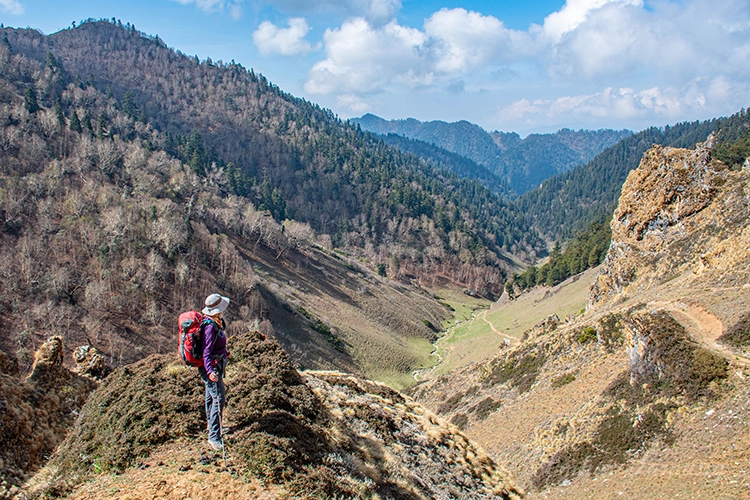
Our amazing trip to Rara Lake started in Kathmandu. First, we flew to Nepalgunj, a lively city in the far western Tarai region of Nepal, close to the Indian border. Right away, we felt the big difference between the climates of Nepalgunj and Kathmandu. The month of May is usually the hottest time of the year in Nepal, and Nepalgunj is known as the hottest place in the country. The temperature there can get as high as 43 or 44 degrees Celsius. When we landed, it was around 33 degrees Celsius, which wasn’t too bad. We hopped on an auto-rickshaw to explore the city. The streets in Nepalgunj were surprisingly wide, with less traffic. The city was also bigger than we expected. The market felt like an Indian: colorful, a bit messy, and really interesting to see.
The next day, our plans suddenly changed. About an hour before our flight from Nepalgunj to Jumla was supposed to take off, we found out it was canceled. The airline didn’t give a clear reason of the cancellation. We had to quickly change our plans and decided to travel by road instead. So, instead of a short flight, we ended up on a jeep ride to Jumla that took more than 10 hours. But it turned out to be an adventure all on its own! The first part of the drive to Surkhet was pretty smooth on a wide, open road. But after driving a few kilometers from Surkhet, things got exciting. The road became narrow, winding along the hillside, bumpy, and very uneven. Some parts were wide enough, some were just barely wide enough for a single car. It was mostly dirt roads with breathtakingly steep drops down to the river. While the changing scenery was interesting to see, the drive was also tiring. A delicious dal bhat meal in Surkhet gave us the energy we needed before we reached our hotel in Rakam, which was quite comfortable and clean.
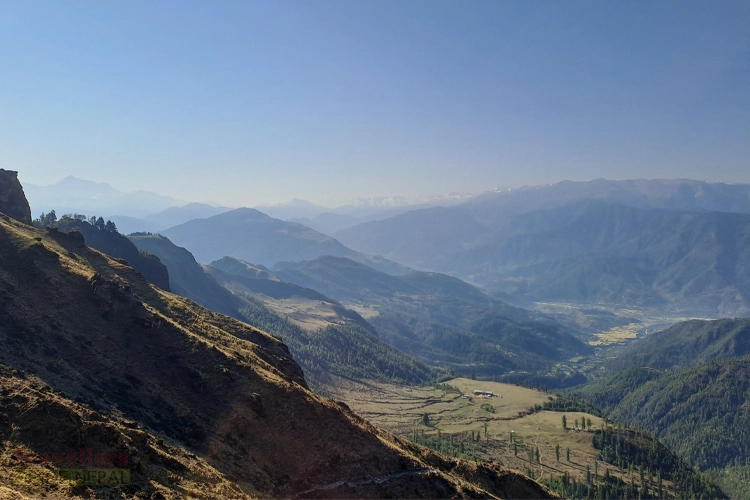
The following morning, we continued our journey by road. As we got closer to Jumla, the scenery gradually changed. It became greener, and we saw small farming villages dotted on the hillsides. We arrived in Jumla around lunchtime and met our trekking team. This included our cook, Nuru, his helper Pemba, and our horseman with his group of five mules and a horse. Their warm welcome and excitement made us feel sure that even though our trip had a bit of a rough start, our trek was really about to begin.
After a quick lunch and ensuring everything was ready, we started our Rara Lake Trek. The first part was a short but steady uphill walk to Chere Chaur, about two hours from Jumla. The fresh mountain air and the sight of the incredible Jumla valley, with its beautiful farming fields and grazing animals, made for a nice start. We camped under the clear Himalayan sky and felt excited for the days ahead.
The next day, we faced our first big challenge: crossing the Jaljala Pass at 3,600m. The gradual and steady uphill climb at the start became steeper as we went higher, especially since Lynda had a cold that day, which made it tough for her. But her determination, the amazing views all around us, and the kindness of her partner, Kim, who helped carry her backpack near the top, made all the effort worth it. After a well-cooked, delicious lunch, we walked downhill to Chala Chaur, where our campsite awaited.
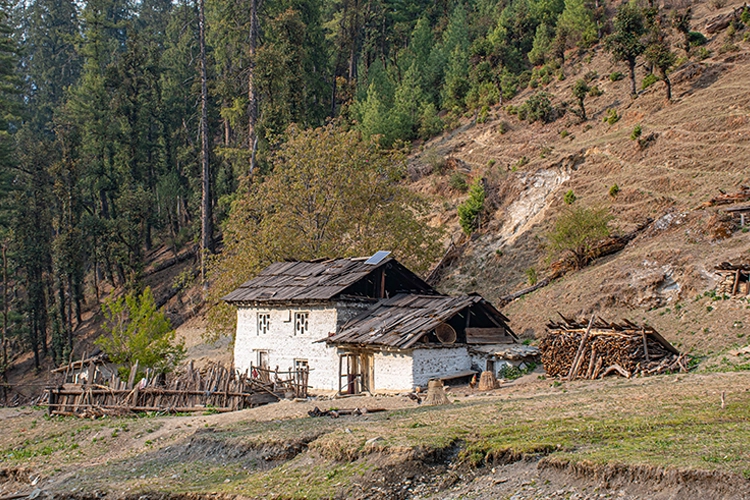
That trek from Chala Chaur to Sinja was a nice change after the hard climb the day before. The path followed the Syaule Khola (River), winding through thick forests and pretty villages. Lynda’s cold was starting to get better, so she could really enjoy the peaceful beauty of the area. When we arrived in Sinja, the local people greeted us with warm smiles, especially the children who were curious about our campsite and our foreign friends.
In the afternoon, we visited the Kankasundari Temple, a most worshiped deity in the entire Sinja Valley, where the local priest gave us blessings. Exploring Sinja Valley felt like going back in time. This old area used to be the capital of the Khas Kingdom. The green fields, traditional houses, and friendly villagers made it a great experience. A spontaneous chat with some schoolchildren, who eagerly said “Namaste” to us, added to the lovely feeling of the day.
Over the next few days, we trekked deeper into Rara National Park. The climb from Sinja to Goresinghe was hard, but because we were getting used to the altitude, it wasn’t as bad as the first day. We started by walking down to the Hima Nadi River, then climbed up to a main road that is under construction; we hardly saw any traffic. When we reached Bota, we passed by a school during the morning assembly and stopped to watch the children praying and doing exercises. An English teacher welcomed us and let us take some pictures. After leaving the school, we walked through fields of barley before starting a steep climb through a narrow valley. Along the way, we saw a pair of martens (small animals like weasels) darting in the bushes and eagles, including a Himalayan griffon, flying high above us. At a small open area near the top, with a temple and mules grazing, we enjoyed a scenic landscape and lunch cooked by Nuru and Pemba. The views of the valley were stunning. After lunch, we entered a wide, open valley where we met a couple herding about 250 or more sheep. They were spinning wool as they watched their animals. it was a peaceful, timeless scene. We really loved walking through this amazing valley and were overwhelmed by the scenery. We made good progress and eventually crossed the Rara National Park checkpoint, reaching a beautiful campsite at Goresinghe, just as a storm arrived, making the temperature drop rapidly.
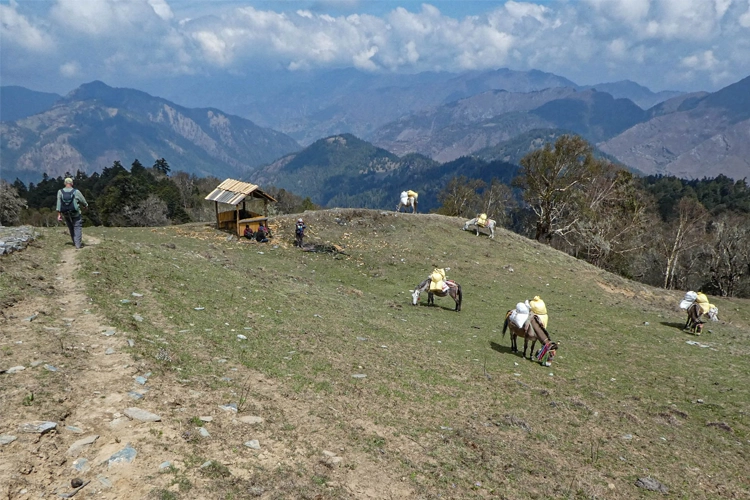
The following day, our plans changed again. Instead of going straight to Rara Lake, we stopped at Majhghat, which was nearby. There was a local festival happening at the lake, and we thought it would be better to avoid the crowds. Seeing many people walking past our campsite confirmed that it was a wise decision we made.
Our walk started with a gentle climb through narrow valleys, where we spotted a Daphe, the colorful national bird of Nepal, and a small Pika, like a rabbit, (a mountain Rat). After about two kilometers of gradual uphill, we climbed steeply again, crossing a pass that felt easier because we were now more used to the altitude. When we reached the top, we saw our first glimpse of Rara Lake and the snow-covered mountains in the distance. After a quick snack with our team near the summit, we walked downhill towards our campsite, enjoying the familiar and pleasant trekking paths through the thick forest and meadows.
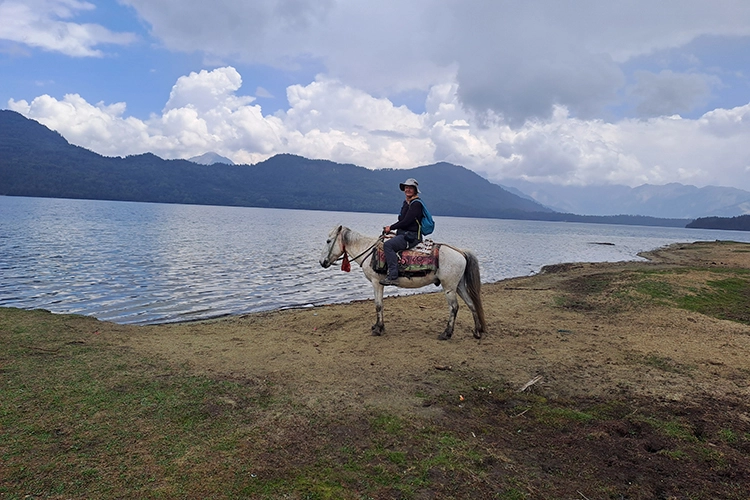
The next morning, instead of going straight to our camp by the lake, we took a difficult but beautiful route via the Murma Top Viewpoint. Even though the uphill walk wasn’t very appealing at first, the amazing panoramic view of Rara Lake and the surrounding landscape from the top was absolutely worth it. We were so glad we did it. The trail went through Murma Village and forests of Rhododendron and Pine trees, making the journey enjoyable. It was late in the season, but as we climbed higher, we saw bright Rhododendron flowers that still looked fresh and beautiful. Unfortunately, the weather wasn’t clear enough to see the majestic mountains. But we did get to see the local people going about their daily lives and interacted with some of them. After enjoying the magnificent views and taking some photos, we walked down a short distance and stopped at a local teahouse for tea and coffee before taking a different path down to our campsite by the lake.
Rara Lake, located inside a national park, is a popular vacation spot for Nepali people who drive part of the way and then hike to the lake. They stay in tents along the shore and spend their time boating, walking, riding horses, and making TikTok videos, which adds a lively feel to the peaceful setting. Our well-equipped campsite had a kitchen and even toilets – a welcome comfort. After lunch, we explored the lake, chatting with friendly locals, including a Swami (a Hindu holy man), Nepal Army soldiers, and a banker from Surkhet, who were doing yoga and praying, all while admiring the beauty of the area. We also visited a nearby army camp and watched soldiers play cricket. That evening, we heard the yelping of jackals around our camp, which made us feel more in the wilderness.
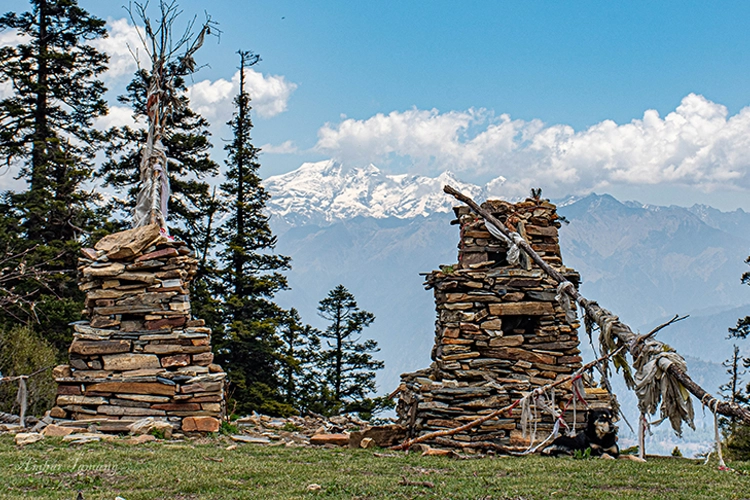
Our plan to sleep in was interrupted by a stunning sunrise. It was the first perfectly clear morning of our trip. As the sun rose behind the distant mountains, its first rays touched Rara Lake and the surrounding hills, creating a magical moment. After enjoying this wonderful start to the day, we had breakfast and watched local tourists riding horses, making noise, and taking TikTok videos. That day’s trek was short and mostly downhill, a welcome break before the next climb. Our campsite was an animal grazing field where mules, cows, and goats also grazed. A restless cow, recently separated from her calf, gave us some unexpected excitement. Away from the tourist crowds, we enjoyed the warm curiosity of the local people, especially the playful children around our camp.
The next day was our hardest, with a 1,000-meter climb. The steep uphill walk challenged even our support team. The initial ascent was steep, but we were fresh in the morning, so it wasn’t too bad. Next, we contoured, passing through beautiful grassy saddles and gently heading up. The final climb to Ghurchi Lagna Pass, at 3,445m, was definitely hard and felt like it would never end under the hot sun. At the top, the view of snow-covered peaks to the north, grassy hills and meadows, and nearby shepherds with their animals made it all worthwhile. A steep walk down led us past the Rara National Park entrance to Bulbule, where we had a delicious lunch. A short walk brought us to our next campsite, Chauta.
The following morning, Lynda woke up with a severe stomachache. She had probably forgotten to clean her hands before eating lunch the day before or had eaten something she wasn’t used to. She felt very weak and couldn’t eat that morning. She struggled through the morning trek. The first part was a gradual uphill walk on a winding dirt road, which wasn’t very pleasant. However, as we continued, we left the road, followed a regular walking trail, and the scenery improved a lot. Near Bumra, we arranged a Jeep ride for Lynda. She headed to Khali Gaon in the Jeep with other local passengers. The bumpy, seatbelt-free journey to Khali Gaon was a memorable adventure for her. The uphill trek to Khali Gaon for the rest of us was long and steep, going through a thick forest. We followed the zigzag road, sometimes trying to take shortcuts. We all arrived at the campsite just before 2 p.m. We arranged a very basic room for Lynda and Kim instead of setting up a tent, thinking it might be a bit more comfortable. This place also had a good toilet.
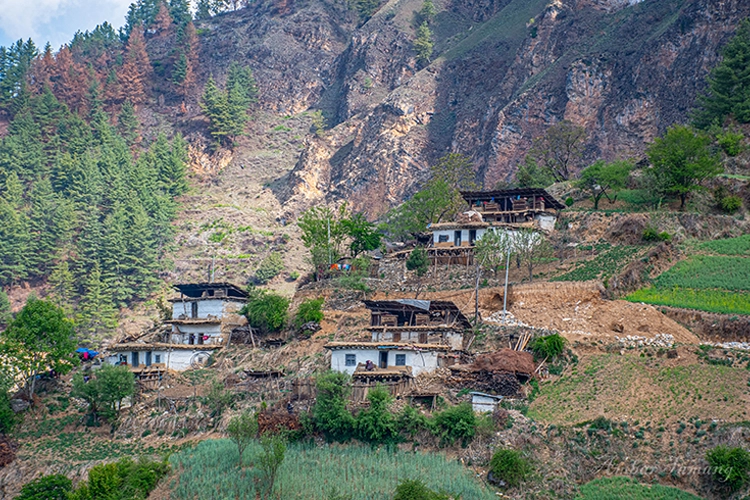
In the morning, frost covered the ground, making our warm stay in the teahouse a blessing. Lynda was feeling better but was still weak. Khali Gaon is an amazing place, with wide open meadows and forested areas, giving great views. We had a wonderful morning in Khali Gaon with clear, sunny weather. The climb to Danphe Lagna Pass (3,662m) was a gentle, short climb, and the steep descent down to Chere Chaur offered stunning views. Our mules, sensing they were close to home, became restless. Back in Jumla, we met the horseman’s family, learned about their business, and watched daily life from a balcony. A student protest, which we initially thought was a sports event, happened below. Since flights from Jumla were not reliable, we decided to take a six-hour drive to Rakam. A hot shower felt like a real luxury after some time. That evening, we shared a final meal together, enjoying delicious local fried fish and dal bhat, and had a great time sharing stories from the trek.
As we expected, our return to Kathmandu was eventful. A broken-down crane blocked a sharp bend in the road, forcing an impressive display of Nepali problem-solving as our driver squeezed through an incredibly tight space. Further along, roadwork held us up again, but we eventually made it to Surkhet. After dropping off Nuru and Pemba, we reached the airport and flew back to Kathmandu.
The Jumla Rara Lake Trek was more than just a physical journey; it was a profound experience of Nepal’s rich culture, natural beauty, and the unexpected events that make every adventure special. From the warmth of the local people to the stunning landscapes, from the joy of reaching Rara Lake to the difficulties of illness and exhaustion, every moment was part of a story we will never forget.
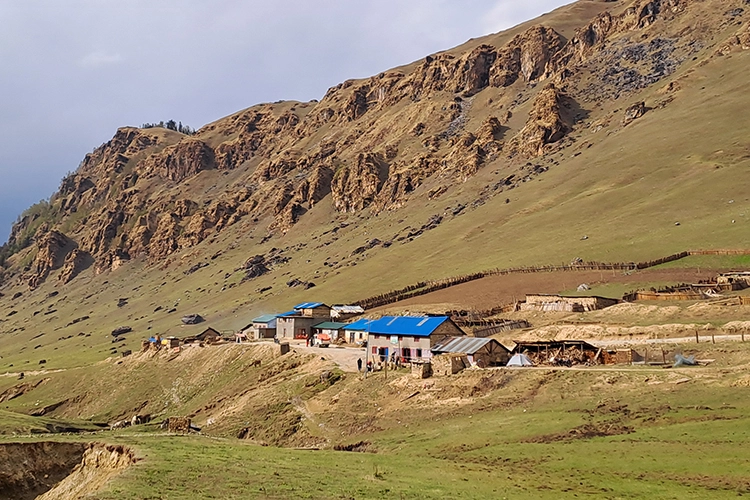
Traveling in Nepal means being flexible, patient, and open-minded. Plans might change, and challenges will arise, but by accepting the unexpected, we discover the real magic of adventure. As we boarded our final flight back to Kathmandu, we carried with us not just memories but a deep appreciation for the incredible people and places that made the Jumla Rara Lake Trek a once-in-a-lifetime experience.
It’s arguably the best trekking destination in far west Nepal. The trek offers a mix of nature, culture, and adventure with breathtaking views. This less-traveled trek is not too difficult and is a great choice for people who want to get away from the usual trekking crowds and enjoy the wilderness with the local people. Come and join Blossom Expeditions for an unforgettable off-the-beaten-path adventure in Far West Nepal. Let us take care of every detail of your trek to Jumla Rara Lake!
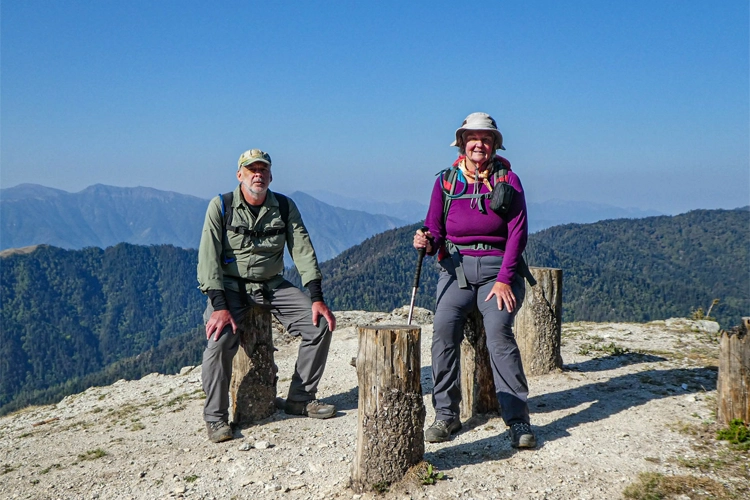
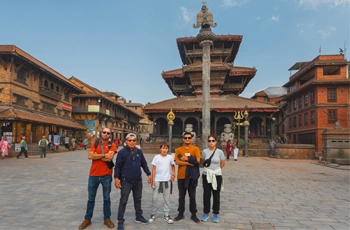
Introduction to the Nagarkot Day Tour Most of the Nagarkot 1-day tours we organize are truly unforgettable. Located at an altitude of 1,930 meters above sea level, Nagarkot is a popular tourist destination near Kathmandu city. From this hilltop, you can enjoy breathtaking sunrises and spectacular views of the majestic Himalayas, including Mount Everest. The surroundin...
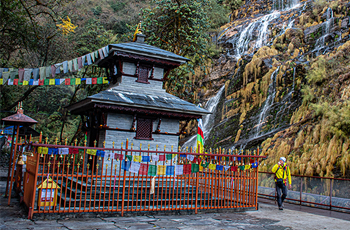
An Unforgettable Journey Through Nepal’s Majestic Himalayas Experience the best of Nepal with a unique trek combining the famous Annapurna Base Camp and the peaceful Khopra Danda, popularly known Khayar Lake Trek. Discover stunning mountains, local culture, and hidden trails. In late November 2024, we went on an amazing adventure in the heart of Nepal's Himalayas. ...
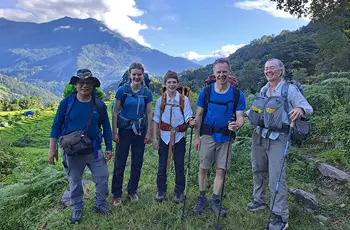
The Makalu Base Camp Trek was a unique adventure in the less-traveled eastern Himalayas of Nepal. Unlike the busier Everest, ...
Comments